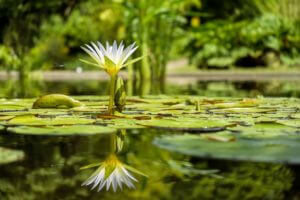A step by step guide to planting pond plants
Once you have completed the construction of your garden pond, you will then want to plan what to put inside it. A pond can be a very attractive feature to your garden if it is has a good selection of pond plants or ornamental fish. Get the natural balance right for your pond and will be virtually self-sustaining.

Firstly, find out what types of pond plants are available and which ones will be best suited to your size pond. If you are going to introduce fish to your pond, then this will also affect your decision on what pond plants to choose. Some aquatic plants are harmful to fish and therefore aren’t recommended. When selecting the type and quantity of aquatic plants, also remember that plants grow and can take over a pond quite quickly.
Pond plants not only create a natural and informal feel to your pond, but also serve many other useful functions.
What aquatic plants will do for your pond
- they absorb nutrients
- oxygenate the water
- reduce the amount of sunlight that enters the water – too much sunlight can lead to algae growth
- provides shelter for fish
- natural biological filtration system
- a good balance of marginals, flatters and oxygenators will maintain a healthy balance in the pond water
- visual impact
- encourage wildlife
Types of pond plants
When visiting a garden centre to select plants choose according to the size pond you have. There is a water plant for every size pond. For small ponds avoid invasive plants unless you are prepared to be on top of continuously cutting back. Plant names which include words such as ‘dwarf’, ‘miniature’, ‘pygmy’ is a good indication that they are suited to small ponds. Most aquatics require at least 5 hours of direct sunlight for optimum growth. Planting too many aquatics or plants not suited to small ponds can result in over crowding and blocking out sunlight.
Native plants will attract amphibians, dragonflies and other wildlife to your pond.
If you want a pond with an impressive display of colour and variety, aim for plants better suited to average size garden ponds. A few examples are listed against each type of plant:
Bog plants – these plants like damp ground rich in organic matter. They are ideal for planting around a wildlife pond where the ground gently slopes into the pond. Bog plants don’t like water-logged ground. Before selecting bog plants check whether they are shade loving or need partial sunlight as with many of the big-leaved bog plants. According to the RHS, the best time of the year to put bog plants into the ground is in the Spring.
Marginals – grown around the periphery of a pond and thrive in areas where there is standing water adding visual interest to a pond. Spike, Rush and Corkscrew are good examples of Marginals. Grow in plant baskets in the shallow depths.
Floaters – do literally that so are very easy to grow because you literally buy and then drop them into your pond. They provide shade and protection to pond inhabitants. Customers should select floaters that withstand frost to avoid having to replace them every year. Floaters add great visual appeal. Duckweed is a floating plant with small leaves and forms a carpet over the water surface. Water Soldier is a worthy choice. Fairy Moss is invasive but easy to control.
Oxygenating – also referred to as submerged plants. Willow, Moss and Parrot’s Feather are good examples.
Water lilies of the small or dwarf variety need planting at a depth of just 10 to 30cm.
They attract wildlife to the pond, providing food, rest and breeding sites for a host of creatures. Pond plant foliage produce oxygen and absorb carbon dioxide and minerals from the water that would otherwise build up and encourage the growth of algae. There are four groups of pond plants. Each group has its role in the healthy balance of your pond. The groups are oxygenators, floaters, marginals and deep-water aquatics.
Oxygenators grow under the water. Their roots and stems are submerged and usually the leaves are submerged as well. They fulfil a useful role in the pond by absorbing nutrients, and so reduce the growth of algae. Oxygenators keep the water clear. They are often bought in bunches. Most oxygenators do not flower, but two exceptions are water violet and water buttercup.
Planting
Pond plants grow best in heavy clay loam soils or a soil specific for aquatic plants. Clay holds nutrients and allows roots to penetrate. It also anchors and supports plants growing in ponds. Planting in plastic mesh baskets gives the option to retrieve aquatics for periodic maintenance and, if frost sensitive then for winterisation too. The baskets allow the roots to grow through and have contact with the water. It is best to match the size of the pot with that of the plant.
Pond plants need fertilising just as garden plants do. The amount and type of fertilzer needed depends on plant type as does amount of sun and temperature. Remember that too much plant fertilization can lead to algae growth. Using slow-release is the preferred option.
It is highly recommended to get the plants established first before introducing fish to your garden pond.





